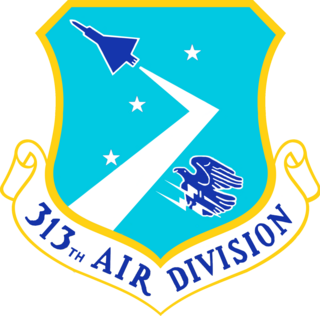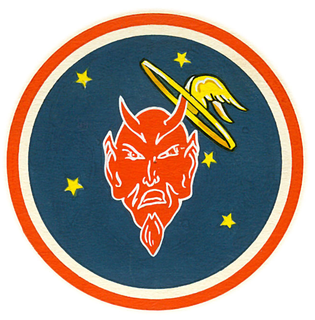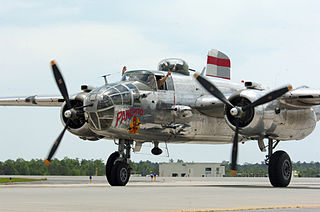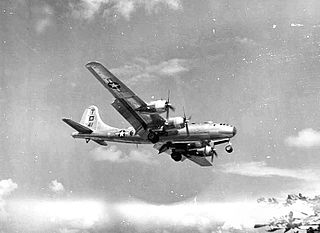
The 506th Air Expeditionary Group is a provisional United States Air Force unit. The group is assigned to the United States Air Forces Central 332d Air Expeditionary Wing, stationed at Joint Base Balad, Iraq.

The 73d Air Division is an inactive United States Air Force unit. Its last assignment was with Air Defense Command at Tyndall Air Force Base, Florida, where it was inactivated on 1 April 1966.

The 318th Fighter Group was a World War II United States Army Air Forces combat organization. It served primarily in the Pacific Ocean theater of World War II.

The 414th Fighter Group is an Air Reserve Component (ARC) of the United States Air Force. It is assigned to the 944th Fighter Wing of Tenth Air Force, Air Force Reserve Command, stationed at Seymour Johnson Air Force Base, North Carolina.

The 357th Fighter Squadron is part of the 355th Fighter Wing at Davis–Monthan Air Force Base, Arizona. It operates Fairchild Republic A-10 Thunderbolt II aircraft training pilots for close air support missions.

The 313th Air Division is an inactive United States Air Force unit. Its last assignment was with Pacific Air Forces at Kadena Air Base, Okinawa. It was inactivated on 1 October 1991.

The VII Fighter Command was a command and control organization of the United States Army Air Forces. Its last assignment was with Far East Air Forces. The Headquarters were based at several locations with Forward command moving with the campaigns. It was inactivated through being redesignated the 20th Fighter Wing and later, the 46th Fighter Wing on 24 August 1948.

The 548th Combat Training Squadron is a United States Air Force squadron assigned to the 57th Operations Group at Fort Polk, Louisiana. It is geographically separated from the 57th, whose headquarters are at Nellis Air Force Base, Nevada. At Fort Polk, the squadron controls multi-service close air support and forward air control aircraft and tactical air control assets in combat exercises with the US Army Joint Readiness Training Center.

The 418th Tactical Fighter Training Squadron is an inactive United States Air Force unit. Its last assignment was with the 58th Tactical Fighter Training Wing, being inactivated at Luke Air Force Base, Arizona on 1 October 1976.

The 547th Intelligence Squadron is an active United States Air Force (USAF) unit. It is assigned to the 365th Intelligence, Surveillance and Reconnaissance Group, stationed at Nellis Air Force Base, Nevada. The squadron serves as the USAFs center for adversary tactics analysis; develops intelligence threat training programs; defines potential threats to the US, provides intelligence support to Air Combat Command's test and evaluation programs and live-fly exercises.

The 416th Fighter Squadron is an inactive United States Air Force unit. Its last assignment was with the 49th Fighter Wing at Holloman Air Force Base, New Mexico. The squadron was inactivated on 1 July 1993.

The 431st Test and Evaluation Squadron is an inactive United States Air Force unit. Its last assignment was with the Tactical Air Command 57th Fighter Wing stationed at Nellis Air Force Base, Nevada. It was inactivated on 30 June 1992.

The 41st Tactical Group is an inactive United States Air Force unit. Its last assignment was with the 7217th Air Division at Cigli Air Base, Turkey, where it was inactivated in 1970. From 1966 to 1970 the group controlled deployed fighter squadrons.

The 531st Tactical Fighter Squadron is an inactive United States Air Force unit, last assigned to the 3rd Tactical Fighter Wing at Bien Hoa Air Base, South Vietnam. The squadron was inactivated on 31 July 1970.

The 512th Fighter Squadron is an inactive United States Air Force unit. Its last assignment was with the 86th Fighter Wing at Ramstein Air Base, Germany, where it was inactivated September 1994.

The 21st Operations Group was an operations group of the United States Air Force (1991-2019) and the United States Space Force (2019-2020). It was assigned to the 21st Space Wing, stationed at Peterson Air Force Base, Colorado.

The 877th Bombardment Squadron is a former United States Army Air Forces unit. It was activated in November 1943, equipped with Boeing B-29 Superfortress bombers, and assigned to the 499th Bombardment Group. After training in the United States, it deployed to Saipan, where it participated in the strategic bombing campaign against Japan, earning two Distinguished Unit Citations. After V-J Day, it returned to the United States, where it was inactivated at March Field, California on 16 February 1946.

The 878th Bombardment Squadron is a former United States Army Air Forces unit. It was activated in November 1943, equipped with Boeing B-29 Superfortress bombers, and assigned to the 499th Bombardment Group. After training in the United States, it deployed to Saipan, where it participated in the strategic bombing campaign against Japan, earning two Distinguished Unit Citations. After V-J Day, it returned to the United States, where it was inactivated at March Field, California on 16 February 1946.

The 879th Bombardment Squadron is a former United States Army Air Forces unit. It was activated in November 1943, equipped with Boeing B-29 Superfortress bombers, and assigned to the 499th Bombardment Group. After training in the United States, it deployed to Saipan, where it participated in the strategic bombing campaign against Japan, earning two Distinguished Unit Citations. After V-J Day, it returned to the United States, where it was inactivated at March Field, California on 16 February 1946.

The 875th Bombardment Squadron is a former United States Army Air Forces unit. The squadron was activated in late 1943 for service during World War II. After training in the United States with Boeing B-29 Superfortress bombers, the squadron moved to the Mariana Islands, where it participated in the strategic bombing campaign against Japan, earning two Distinguished Unit Citations before the end of hostilities in August 1945. The squadron returned to the United states in December 1945 and was inactivated in March 1946, and its personnel and equipment transferred to another organization.






















